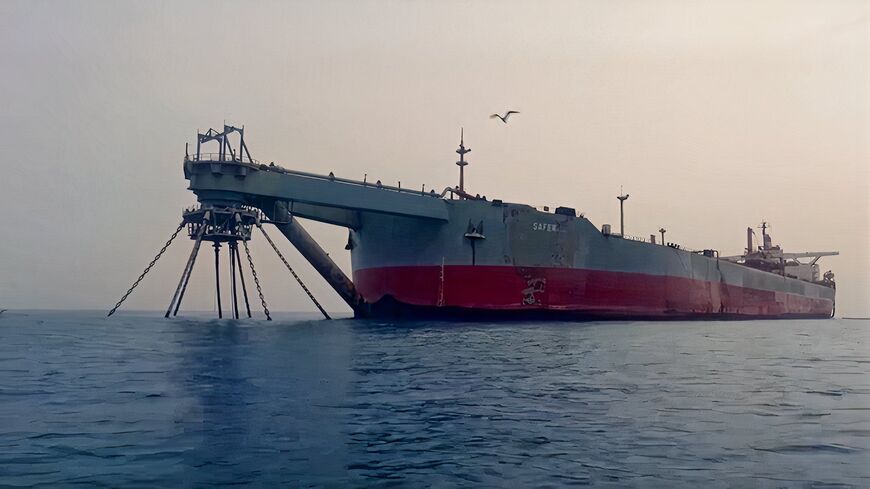World Looks Away as Oil Disaster Looms off Yemen’s Coast
ENVIRONMENT, 18 Jul 2022
Elizabeth Hagedorn | Al-Monitor - TRANSCEND Media Service
Time is running out to prevent what Yemen envoy Tim Lenderking warns will be a “massive oil spill the likes of which the world has not seen.”
11 Jul 2022 – Off the coast of Yemen lies an aging oil tanker that could rupture at any moment. Experts say it’s not a matter of if but when the FSO Safer leaks more than one million barrels of light crude oil into the sea — four times the amount spilled in the Exxon Valdez disaster of 1989.
Environmental groups warn that one of the worst man-made environmental crises in history is imminent. But few governments are willing to open their wallets to prevent it.
“If we don’t act to prevent the breakup of the Safer, then there will be a massive oil spill the likes of which the world has not seen,” US special envoy for Yemen Tim Lenderking told Al-Monitor in an interview. Lenderking likens the decades-old vessel to a ticking time bomb that could unleash “catastrophic consequences economically and environmentally.”
The Safer is anchored several nautical miles from Ras Isa port on the rebel-held western coast of Yemen, a country shattered by more than seven years of war between the Saudi-backed government and the Iran-aligned Houthis who control the vessel.
The Houthis haven’t performed maintenance on the Safer since they seized it from the state-run oil company in 2015. The decaying ship is now beyond repair.
The systems used to pump inert gas into the Safer’s tanks stopped functioning in 2017. Seawater seeped into the engine room in 2020 and highly flammable gases have accumulated in the cargo tanks, according to UN reports. A mere cigarette butt could easily ignite a fire or explosion.
The Houthis have agreed to a United Nations plan to safely remove the oil. After years of obstructing UN efforts to send inspectors onboard the Safer, the rebels signed an agreement in March that would allow the UN to offload the oil onto a temporary vessel, before eventually transferring it to a long-term replacement vessel for the Houthis.
The entire plan costs $144 million, a drop in the bucket compared to the estimated $20 billion it would cost to clean up the inevitable oil spill.
Pledges have trickled in from a handful of governments including the United States, Saudi Arabia, the Netherlands, Germany, Qatar and Switzerland. But as of this writing, the UN is still nearly $20 million short of what’s needed to carry out the initial emergency transfer operation. It’s launched a crowdfunding campaign in hopes of plugging the funding gap.
“Any donor in a position to support the UN plan needs to do so now,” said David Gressly, the UN resident and humanitarian coordinator for Yemen. “The stakes are too high to wait or rely on someone else to provide the funds.”
A spill would have a devastating impact on Yemen, already the Arab world’s poorest country. The leaked oil would wipe out fisheries and force the closure of the nearby Hodeidah and Saleef ports, which are used to deliver essential food, fuel and medicine to a population largely dependent on humanitarian aid.
“We just would not be able to fathom, much less cope with, the humanitarian fallout from the spill of the FSO Safer,” said Ian Ralby, chief executive of I.R. Consilium, a maritime law and security consultancy. “The impact of this kind of spill would not last a few weeks or months, but generations.”
The Safer is situated in one of the world’s biodiversity hotspots. Holm Akhdar, an independent Yemen-based environmental group, says a potential spill would threaten some 1.5 million migratory birds and kill off 969 species of coastal and deep-sea fish. The thick film of oil would prevent oxygen and sunlight from reaching some 300 species of coral on the seafloor.
Despite the humanitarian and environmental concerns, neighboring countries have been slow to pony up funds. The United Arab Emirates, one of the main participants in the Saudi-led coalition, has not contributed.
Part of Lenderking’s pitch to potential donors is that the Safer isn’t just a Yemen issue. The consequences of a spill will reverberate well beyond the war-wracked country’s territorial waters.
Experts say the slick could reach the coastlines of Djibouti, Eritrea and Saudi Arabia and contaminate drinking water supplies for the entire region. The spillage could also disrupt one of the world’s busiest commercial shipping routes and wreak havoc on Red Sea tourism.
“It’s in their neighborhood,” said Lenderking. “We’ve also been emphasizing to any potential donor: This is not just the Yemen issue, or even just the Gulf issue. It’s a global commerce issue.”
Lenderking and Gressly are also appealing to the private sector, which has yet to make any financial contributions to the UN plan. Paul Horsman, project lead of the Safer response team at Greenpeace International, says the oil industry in particular has an obligation to help after profiting off Red Sea oil resources for decades.
“The pocket money that they keep in their drawers could pay for this cleanup or salvage operation. And yet, the oil industry has been nowhere to be seen,” Horsman said.
Time is of the essence. The UN had hoped to start work in July, giving crews enough time to carry out the four-month operation before high winds and turbulent currents increase the likelihood of the Safer breaking apart.
“Every day we wait for funding pushes us deeper into that period and closer to the day that we have an environmental and humanitarian catastrophe on our hands,” Gressly said.
_________________________________________
 Elizabeth Hagedorn is Al-Monitor’s State Department correspondent. She previously reported on the region as a freelance journalist in Turkey and Iraq for publications including Middle East Eye, The National and The Guardian. Email: ehagedorn@al-monitor.com
Elizabeth Hagedorn is Al-Monitor’s State Department correspondent. She previously reported on the region as a freelance journalist in Turkey and Iraq for publications including Middle East Eye, The National and The Guardian. Email: ehagedorn@al-monitor.com
Tags: Fossil fuels, Marine pollution, Middle East, Oil Spill, Yemen
DISCLAIMER: The statements, views and opinions expressed in pieces republished here are solely those of the authors and do not necessarily represent those of TMS. In accordance with title 17 U.S.C. section 107, this material is distributed without profit to those who have expressed a prior interest in receiving the included information for research and educational purposes. TMS has no affiliation whatsoever with the originator of this article nor is TMS endorsed or sponsored by the originator. “GO TO ORIGINAL” links are provided as a convenience to our readers and allow for verification of authenticity. However, as originating pages are often updated by their originating host sites, the versions posted may not match the versions our readers view when clicking the “GO TO ORIGINAL” links. This site contains copyrighted material the use of which has not always been specifically authorized by the copyright owner. We are making such material available in our efforts to advance understanding of environmental, political, human rights, economic, democracy, scientific, and social justice issues, etc. We believe this constitutes a ‘fair use’ of any such copyrighted material as provided for in section 107 of the US Copyright Law. In accordance with Title 17 U.S.C. Section 107, the material on this site is distributed without profit to those who have expressed a prior interest in receiving the included information for research and educational purposes. For more information go to: http://www.law.cornell.edu/uscode/17/107.shtml. If you wish to use copyrighted material from this site for purposes of your own that go beyond ‘fair use’, you must obtain permission from the copyright owner.
